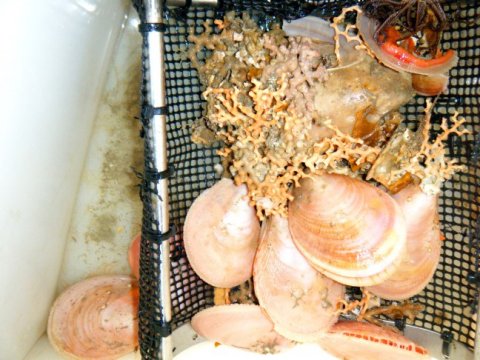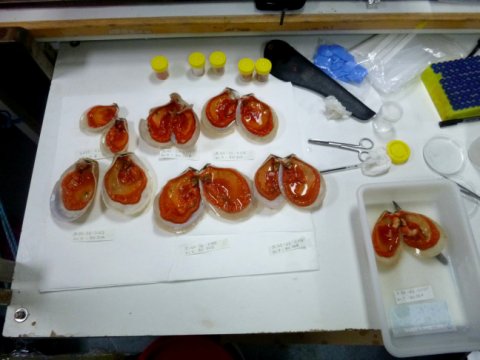Becoming a marine biologist for a day (or two)!
This blog post was written by Tahmeena Aslam, a PhD student in physical oceanography at the University of East Anglia
Sometimes we have so many biological samples to process that even those of us (like myself) who work in a non-biological field are roped in to help. I study physical oceanography and until now I’ve never appreciated how “clean” data collection has been for me! Here are some of my thoughts from my few days as a biologist helping Laura to process the Acesta clams that she has written about previously:
It’s a bit disconcerting when your colleagues, who seemed fairly normal, suddenly whip out their dissection kits and gain a morbid fascination with slicing up flesh and muscle. And you’re trapped on a ship with them in the middle of the ocean with no chance of escape.
Processing samples involves getting very cold. Dissecting occurs in a cold room (4ºC), so as to preserve specimens. Cue wooly hats, multiple layers of clothing and jumping up and down to keep warm … in the middle of August.
Processing takes time.
Record keeping is key and we don’t want to waste any material that we’ve gone all the way to the bottom of the ocean to collect. Samples will be sent to multiple scientists to ensure that each life lost on the sea floor is not in vain.
No anthropomorphising of specimens allowed. Do you really want to name that shrimp “Dave” and then “preserve” him? No.
It’s weirdly satisfying! Doing something practical, when usually a lot of my work on a cruise is done sat behind a computer while my robot or instrument collects data, is really refreshing.
It makes you really think about the connections between the biology we see and the differing oceanographic and geological settings that they are found in. Why is this clam found here and not in that other part of the canyon? What influence does the water column or the geology have on their distribution? On an interdisciplinary cruise like this, it’s great to work with scientists from different disciplines and to start to figure out the reasons why amazing habitats, such as the ones found here in Whittard Canyon, occur where they do.







